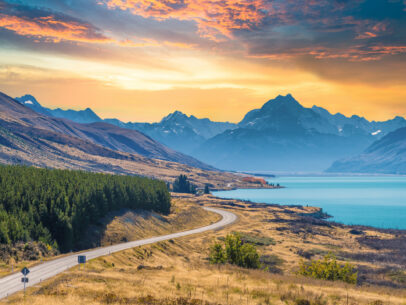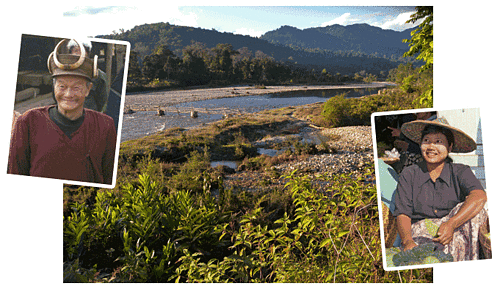
The Bird’s Word Blog
Trek to the Last Village

January is the ideal month to explore the northern most valleys of Burma, one of the least visited regions of the Himalayas. Rich with birdlife and friendly cultures we walked through towering forests and along crystal clear streams and did not encounter any other foreign travelers.
A Quick Stop in Yangon
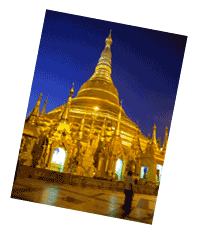 This was my fourth visit to Burma so I had some sense of what to expect, but I was pleasantly surprised by what we found upon arrival in Yangon. There is a new airport with efficient immigration and customs. Changing money was easy. Everyone was predictably courteous. Nothing about this government encounter seems evil or authoritarian. Yangon has moderate traffic, but the city is clean. The ride to Kandawgyi Palace Hotel was entertaining for the passing display of ancient and modern buildings, vehicles and lifestyles. We spent two nights here on arrival with sightseeing to several markets, the riverfront and the great Shwedagon Pagoda. This enormous golden Buddhist stupa is the most sacred (and most valuable) Buddhist site in Myanmar. Every visitor should spend
This was my fourth visit to Burma so I had some sense of what to expect, but I was pleasantly surprised by what we found upon arrival in Yangon. There is a new airport with efficient immigration and customs. Changing money was easy. Everyone was predictably courteous. Nothing about this government encounter seems evil or authoritarian. Yangon has moderate traffic, but the city is clean. The ride to Kandawgyi Palace Hotel was entertaining for the passing display of ancient and modern buildings, vehicles and lifestyles. We spent two nights here on arrival with sightseeing to several markets, the riverfront and the great Shwedagon Pagoda. This enormous golden Buddhist stupa is the most sacred (and most valuable) Buddhist site in Myanmar. Every visitor should spend 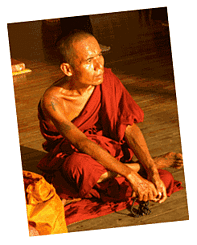 a couple of hours here, preferably around sunset and if possible on the night of a full moon when thousands of lamps are lit. It is a photographer’s delight. In contrast to many countries, most people in Myanmar are pleased and flattered to have their picture taken and never ask for money. At Shwedagon, among the many pilgrims, we observed a monk meditating by looking directly at the setting sun.
a couple of hours here, preferably around sunset and if possible on the night of a full moon when thousands of lamps are lit. It is a photographer’s delight. In contrast to many countries, most people in Myanmar are pleased and flattered to have their picture taken and never ask for money. At Shwedagon, among the many pilgrims, we observed a monk meditating by looking directly at the setting sun.
Elsewhere we visited a new, spacious, open and clean vegetable market inviting not only pictures, but conversations about the nature and origins of the many produce items for sale.
Flight hopping to Putao
Our destination was the northern most tip of Myanmar accessible by a long, two stop flight via Mandalay and Myitkina. The ATR-72 turboprop aircraft of Air Bagan was smooth and comfortable. We flew low enough to observe the landscapes below. The farther north we flew the more extensive the forest became and the clearer the streams. There are only about four flights per week to Putao and the good weather season is from October to April. Road access is possible in the dry season but the roads are rough and tortuous. 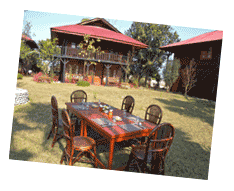 The lack of traffic and modern buildings gave Putao a friendly village feeling.The Putao Trekking House (left) where we stayed for three nights was an especially comfortable and hospitable base. Built according to local architectural style, but from beautiful local hardwoods, a generator supplements limited local electrical supply. Rooms have comfortable bedding and there are attached, Western style bathroom facilities. It was a last chance to charge camera batteries. We enjoyed a local culture show in the spacious bar, dining and meeting hall cum arts and crafts museum. The meals at Putao Trekking House are superb. The landscaped grounds may be a good place to start your bird list. It is an easy walk to to the local morning market and there are bicycles available for excursions farther afield.
The lack of traffic and modern buildings gave Putao a friendly village feeling.The Putao Trekking House (left) where we stayed for three nights was an especially comfortable and hospitable base. Built according to local architectural style, but from beautiful local hardwoods, a generator supplements limited local electrical supply. Rooms have comfortable bedding and there are attached, Western style bathroom facilities. It was a last chance to charge camera batteries. We enjoyed a local culture show in the spacious bar, dining and meeting hall cum arts and crafts museum. The meals at Putao Trekking House are superb. The landscaped grounds may be a good place to start your bird list. It is an easy walk to to the local morning market and there are bicycles available for excursions farther afield.
We left early the next morning by 4×4 for 20 km trip to the trailhead for our trek. I was surprised to travel through extensive native grassland plains, a very rare habitat in this part of Asia, where most level land is claimed for agriculture. At several river crossings we all had to get out and walk across the creaky bridges. The rivers they spanned were crystal clear. At the point where the road became a path we started walking. Our group of five had a support staff of 15 including a guide, cook, guide and cook assistants and local porters. This area is so remote almost no one speaks Burmese, let alone English. But people along the way in fields, houses and on the trail were as curious about us as we were about them. Smiles, gestures and sharing the digital images in our camera view finders all helped to create multi-media conversations. While English is a subject taught in the schools, we happened to meet a high school English teacher in Putao and it was extremely difficult to communicate with him without the assistance of our guide-translator.
The first day of our trek was the most difficult as we ascended a steep track over Mt Shangaung (4500’), a climb of over 3,000’. We all made it up and over and our reward was a more gentle down slope through beautiful broad leaved evergreen forest eventually arriving at Namro River and our night stop at Wasandum, a Rawan Village. A few homes set among rice terraces were our neighbors for the night as we shared the second level floor of the village guest house. We enjoyed a fire built in a square fire pit inset in the floor of the house. Off in the distance were heard the congregants singing in the village church.
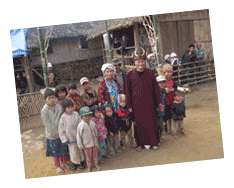 Our second day of trekking, by comparison was almost level as we hiked up the Namlang River Valley to to Ziyadam. The weather was clear and cool and the snowy Himalayan peaks came into view. There was no haze in the air and the river was so clear we could see the fish swimming. We passed a house preparing for a wedding and the families already gathered willingly posed for pictures. We were invited to the ceremony, but still had about 9 kilometers of hiking to complete that day. I was impressed that some villagers along the way had constructed miniature hydro electricity installation that supplied enough power for basic lighting and a radio or cooking appliance. Even though there was little about the architecture, agriculture or local lifestyle that identified the century we were in, a very simple, fragile, part-time electrical connection seemed to give people a great sense of pride and increased well-being. This far beyond roads, most of the bridges were made of bamboo and saplings. The water level in the streams was quite low so we had no problem crossing the simple structures. It was evident that as the water levels rise May and June, this trail and access to these villages would be much more of a hiking challenge.
Our second day of trekking, by comparison was almost level as we hiked up the Namlang River Valley to to Ziyadam. The weather was clear and cool and the snowy Himalayan peaks came into view. There was no haze in the air and the river was so clear we could see the fish swimming. We passed a house preparing for a wedding and the families already gathered willingly posed for pictures. We were invited to the ceremony, but still had about 9 kilometers of hiking to complete that day. I was impressed that some villagers along the way had constructed miniature hydro electricity installation that supplied enough power for basic lighting and a radio or cooking appliance. Even though there was little about the architecture, agriculture or local lifestyle that identified the century we were in, a very simple, fragile, part-time electrical connection seemed to give people a great sense of pride and increased well-being. This far beyond roads, most of the bridges were made of bamboo and saplings. The water level in the streams was quite low so we had no problem crossing the simple structures. It was evident that as the water levels rise May and June, this trail and access to these villages would be much more of a hiking challenge.
Several of us were alert for the different species of birds we observed along the trail. On this day we counted Ibisbill, Brown Dipper, Black Eagle, Northern Lapwing, Indian Cormorant, Blue-eared Kingfisher, Great Hornbill (at left), Mountain Imperial Pigeon, Yellow-bellied Fantail and Collared Scops Owl among our observations.
Arrival at Ziyadam
We finally arrived at the guest house at Ziyadam, the last village in this valley before the trail ends and the steep mountain slopes begin. It is still at least a three day walk from here to reach the glaciers which look like they are just a couple of miles away. We enjoyed the environs of Ziyadam which offered great views, a variety of natural environments to explore and friendly local people. We spent two days here and might have enjoyed another. The community organized a simple cultural show welcome and we were invited to join the long snake dance as dusk fell. Our host was a local hunter who led us on a nature hike which tested out fitness and ability to squirm and wiggle through passageways he cut through the brush and bamboo. We did not see any significant wildlife, but gibbons called from the deep forest above us.
While on the trek we enjoyed excellent and ample meals. A peek in the kitchen revealed that our cook accomplished his magic over a single stove. His cooking was not only tasty and nutritious, but none of our party suffered any kind of digestive distress and there was always enough for second helpings. In general, I was impressed by the general attention villages gave to sanitation and public health, in contrast to many remote villages I have visited in Nepal, India and China. In this poor region there are few resources for education, medical care or public services, yet the villages were neat and clean. Village headmen we met had some medical training and most children were attending school, though the schools had scant facilities and teachers had little training.
Sad to Leave
We left many of our extra medicines behind with a headman whom we were confident could utilize them wisely. Our host operator Journeys Nature and Culture Explorations, supports a number of orphans in school and has contributed significantly to village income by hiring people to help accommodate groups like ours. I realize many people feel that it is not politically correct to visit Burma, but it was evident to all of us that our group was supplying information, medicine, clothing, training and income to poor, but motivated people who receive no services from their government. This dynamic of willing traveler donors interacting and supporting highly appreciative local villagers gave everyone a good feeling and a sense that this kind of tourism is a most satisfying form of efficiently-delivered and highly-targeted foreign aid. Our own government tries to make it difficult for the autocratic rulers of Myanmar by discouraging tourism, denying visas and penalizing American businesses who try to operate in Myanmar. As individual ambassadors of goodwill, travelers can slip through this political and institutional boycott and deliver meaningful assistance to the poorest and most deserving people of Burma.
If you travel to remote areas of Burma think about leaving things like clothing, school supplies, children’s books, tooth brushes, OTC medicines and insect repellent behind as gifts for local people.
Thanks to our hardy and fit group members from left- Jennifer Lanaway, Peter Ostlind, Kishan Chetry (our host), Paul Sively, Ole Lorenzetti. Prior to our trek they were enjoying breakfast at Putao Trekking House.
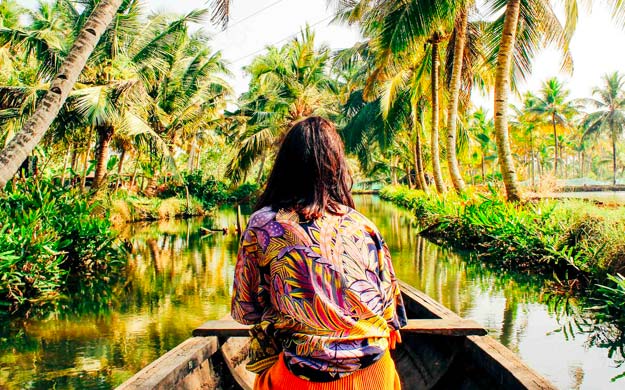
Design an adventure with Journeys International!
With over 40 years of experience, we create experiences that match your goals.
Start Planning